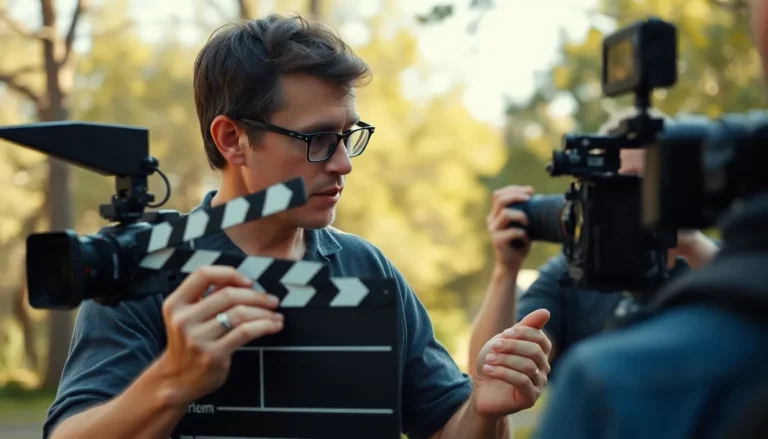Ever found yourself glued to the screen, unable to look away from a movie that’s just too good? That’s the magic of addictive cinema. It pulls viewers in with gripping plots, unforgettable characters, and those jaw-dropping twists that leave you questioning your life choices. But what makes these films so irresistible?
Table of Contents
ToggleUnderstanding Addictive Movie Dissection
Addictive movies create a powerful allure, drawing viewers into immersive experiences. Elements such as storytelling and pacing play significant roles in this phenomenon.
The Concept of Addiction in Cinema
Addiction in cinema often stems from viewers’ emotional connections with characters and narratives. Films that evoke strong feelings can lead to repeated viewings. Examples include cult classics that resonate long after the credits roll. Certain genres, like thrillers or dramas, heighten suspense, prompting urgency to know what happens next. This cycle of fascination reinforces the attraction, making viewers seek similar experiences.
Psychological Triggers in Films
Psychological triggers significantly influence viewer engagement with films. Techniques such as cliffhangers keep audiences invested in plot outcomes. Soundtracks also enhance emotional responses, embedding memorable themes in the viewers’ minds. Shock value becomes another crucial factor; unexpected twists disrupt viewers’ expectations. Crafting relatable characters constructs a bond, drawing viewers in repeatedly. These elements combine, effectively creating a compelling narrative that engrains itself in memory.
Key Elements of Addictive Movies


Addictive movies captivate viewers through distinct elements that create a lasting impact. These elements intertwine, enhancing the overall experience and drawing audiences in.
Compelling Storylines
Compelling storylines drive viewer engagement. Intricate plots often feature unexpected twists and turns that maintain interest. Each storyline presents unique conflicts that characters must navigate. These challenges serve as hooks, prompting audiences to invest emotionally. Films showcasing layered narratives elevate viewer anticipation, making them eager to uncover outcomes. Thrillers and dramas frequently excel in this area, offering layered stories that resonate with audiences.
Relatable Characters
Relatable characters anchor addictive movies. Viewers often form strong connections with characters they see themselves in or aspire to be. A character’s struggles and triumphs evoke empathy, making the story more compelling. Development plays a crucial role; dynamic arcs allow characters to experience growth that mirrors real-life challenges. Iconic films often feature characters with relatable flaws, driving home the connection. This emotional investment encourages multiple viewings, as viewers wish to follow their favorite characters’ journeys.
Suspense and Cliffhangers
Suspense and cliffhangers enhance movie addictiveness significantly. Strategic pacing creates tension, drawing viewers to the edge of their seats. Each cliffhanger leaves audiences craving resolution, fostering a desire to continue watching. Films that masterfully employ this technique often incorporate shocking revelations or unforeseen developments. High-stakes situations amplify the urgency, making it difficult for viewers to turn away. Situations that intertwine suspense and character arcs lead to memorable cinematic experiences that linger long after viewing.
Analyzing Famous Examples
Addictive movies leave a lasting impression on audiences. Their captivating elements resonate and often inspire deeper analysis.
Cultural Impact of Iconic Films
Iconic films shape cultural narratives and influence societal trends. Movies like “The Godfather” offer profound insights into power dynamics, while “Pulp Fiction” redefined nonlinear storytelling. Each film reflects societal values, prompting discussions around morality and ethics. “Star Wars” showcases universal themes of good versus evil, creating dedicated fan bases. Viewers often reference these films in everyday conversations, establishing a cultural lexicon. The impact extends beyond immediate box office success, leading to merchandise, spin-offs, and extensive fan analysis. Consequently, these iconic films enhance collective cultural memory, becoming benchmarks for cinematic excellence.
Viewer Engagement Techniques
Techniques employed in addictive films significantly boost viewer engagement. For instance, films often utilize cliffhangers, compelling viewers to remain invested. Think of “Inception,” which concludes with an ambiguous ending, spurring extensive theories. Emotional scoring deepens connections, as music elevates key scenes and intensifies audience reactions. Memorable characters resonate and endure in popular culture, allowing audiences to revisit familiar struggles. Thrillers leverage suspenseful pacing to maintain interest, as seen in “Seven,” where tension escalates with each plot twist. By employing these engagement strategies, films foster an immersive experience that keeps viewers returning for more.
The Role of Cinematography
Cinematography plays a crucial role in creating immersive experiences in addictive movies. Visual storytelling techniques engage viewers instantly and effectively.
Visual Techniques That Captivate Audiences
Camera angles enhance narrative depth, fostering emotional connections. For example, close-ups reveal characters’ subtle expressions, drawing audiences into their inner worlds. Wide shots establish setting, allowing viewers to grasp the context and atmosphere. Dynamic movement, such as tracking shots, maintains interest and builds excitement during critical moments. Additionally, color palettes evoke specific emotions, subtly influencing the audience’s reactions throughout the film. The combination of these visual techniques captivates audiences, making them eager to return to the story again and again.
The Influence of Sound Design
Sound design complements cinematography by amplifying the overall experience. Loud booming effects during action scenes heighten tension, creating an electrifying atmosphere. Conversely, soft background melodies evoke nostalgia or sadness, deepening emotional engagement with the characters. The use of silence strategically amplifies pivotal moments, allowing viewers to process intense emotions. Diegetic sounds, like footsteps or whispers, immerse audiences within the film’s world, enhancing realism. Together, these elements integrate to create a compelling auditory landscape that draws viewers into the narrative, often prompting repeat viewings.
Addictive movies leave a lasting impact on viewers by intertwining engaging narratives with emotional depth. Their ability to create immersive experiences through effective storytelling and strong character development ensures audiences return time and again. The psychological triggers that enhance viewer engagement, from suspenseful pacing to evocative sound design, play a crucial role in this phenomenon.
As audiences navigate the complex layers of these films, they form connections that extend beyond the screen. This dynamic interplay between viewer and film fosters a cultural dialogue that keeps these movies relevant long after their release. Ultimately, addictive cinema not only entertains but also resonates deeply, making it a vital part of the cinematic landscape.




